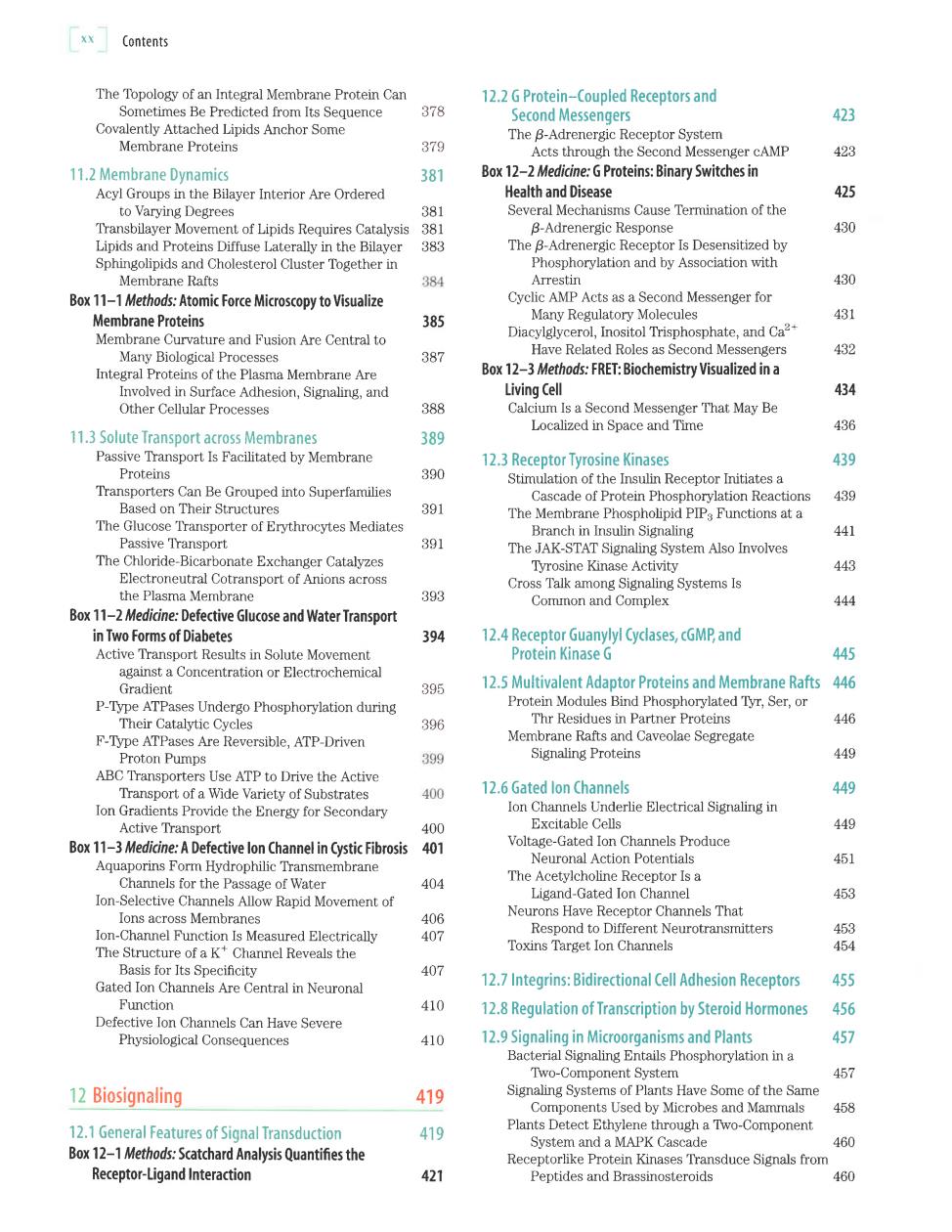
ContentsThe Topology of an Integral Membrane Protein Can12.2G Protein-Coupled Receptors and378Sonetimes BePredicted from Its Sequence423SecondMessengersCovalently Attached Lipids Anchor SomeTheβ-Adrenergic ReceptorSystem379MembraneProteins423Acts through the Second Messenger cAMPBox12-2Medicine:GProteins:BinarySwitches in11.2MembraneDynamics381425Health and DiseaseAcyl Groups in the Bilayer Interior Are Ordered381Several Mechanisms Cause Termination of theto Varying Degrees430β-Adrenergic ResponseTransbilayer Movement of Lipids Requires Catalysis381383The β-Adrenergic Receptor Is Desensitized byLipids and Proteins Diffuse Laterally in the BilayerPhosphorylation and by Association withSphingolipids and Cholesterol Cluster Together in430384ArrestinMembraneRaftsCyclic AMP Acts as a Second MessengerforBox11-1Methods:AtomicForce MicroscopytoVisualize431Many Regulatory Molecules385MembraneProteinsDiacylglycerol, Inositol Trisphosphate,and CaMembrane Curvature andFusion Are Central to432Have Related Roles as Second Messengers387Many Biological ProcessesBox12-3Methods:FRET:BiochemistryVisualized inaIntegral Proteinsof the Plasma Membrane Are434Living CellInvolved in SurfaceAdhesion,Signaling,and388Calciurn Is a Second Messenger That May BeOther CellularProcesses436Localized in Spaceand Tirne11.3 Solute Transport across Membranes389Passive Transport Is Facilitated by Membrane43912.3ReceptorTyrosineKinases390ProteinsStimulation of the Insulin Receptor Initiates aTransporters Can Be Grouped into Superfamilies439Cascade of Protein Phosphorylation Reactions391Based on Their StructuresTheMembranePhospholipidPIPsFunctions ataThe Glucose Transporter of Erythrocytes MediatesBranch in Insulin Signaling441Passive Transport391The JAK-STAT Signaling SystemAlso InvolvesThe Chloride-Bicarbonate Exchanger CatalyzesTyrosine Kinase Activity443Electroneutral Cotransportof AnionsacrossCross Talk among Signaling Systems Is393thePlasma Membrane444Cormunon and ConplexBox11-2Medicine:DefectiveGlucose andWaterTransport39412.4ReceptorGuanylylCylases,cGMP,andinTwoForms of Diabetes445Protein KinaseGActiveTransport Results in Solute Movementagainst a Concentration or Electrochemical12.5MultivalentAdaptorProteinsandMembraneRafts446395GradientProtein Modules Bind Phosphorylated Tyr, Ser, orP-Type ATPases Undergo Phosphorylation during446ThrResiduesinPartnerProteinsTheir Catalytic Cycles396Membrane Rafts and Caveolae SegregateF-Type ATPases Are Reversible, ATP-Driven449Signaling Proteins399ProtonPumpsABC Transporters Use ATP to Drive the Active44912.6Gated lon ChannelsTransport of a Wide Variety of Substrates400lon Channels Underlie Electrical Signaling inIonGradients ProvidetheEnergyforSecondary449ExcitableCells400Active TransportVoltage-Gated Ion Channels ProduceBox 11-3Medicine:A Defective lon Channel in CysticFibrosis401451Neuronal Action PotentialsAquaporins Form HydrophilicTransmembraneThe Acetylcholine Receptor Is aChannels for the Passage of Water404453Ligand-Gated Ion Channellon-Selective Channels AllowRapid Movement ofNeurons Have ReceptorChannels That406Ions across Menbranes453Respond to Different NeurotransmittersIon-Channel Function Is Measured Electrically407454ToxinsTargetIonChannelsThe Structure of a K+ Channel Reveals the407Basis for Its Specificity12.7 Integrins:Bidirectional Cell Adhesion Receptors455Gated Ion Channels Are Central in Neuronal410Function12.8 Regulation of Transcription bySteroid Hormones456Defective lon Channels Can Have Severe45712.9SignalinginMicroorganismsand PlantsPhysiological Consequences410Bacterial Signaling Entails Phosphorylation inaTwo-Component System457Signaling Systems of Plants Have Some of the Same12 Biosignaling419458Components UsedbyMicrobes and MammalsPlants Detect Ethylene through a Two-Component12.1General Features of Signal Transduction419460SystemandaMAPKCascadeBox12-1Methods:Scatchard AnalysisQuantifiestheReceptorlike ProteinKinases Transduce Signals from421Receptor-LigandInteraction460Peptides and Brassinosteroids
xx [ontents The Topology of an Integral Membrane Protein Can Sometimes Be Predicted from Its Sequence Covalently Attached Lipids Anchor Some Membrane Proteins 11.2 Membrane Dynamics Acyl Groups in the Bilayer Interior Are Ordered to Varying Degrees Ttansbilayer Movement of Lipids Requires Catalysis Lipids and Proteins Diffuse Laterally in the Bilayer Sphingolipids and Cholesterol Cluster Together in Membrane Rafts Box 11-1 Methods: Atomic Force Microscopy to Visualize Membrane Proteins Membrane Curvature and Fusion Are Central to Many Biological Processes Integral Proteins of the Plasma Membrane Are Involved in Surface Adhesion, Signaling, and Other Cellular Processes I1"3 Solute Transport across Membranes Passive Transport Is F acilitated by Membrane Proteins Tfansporters Can Be Grouped into Superfamilies Based on Their Structures The Glucose Ttansporter of Erythrocytes Mediates Passive T[ansport The Chloride-Bicarbonate Exchanger CaLalyzes Electroneutral Cotransport of Anions across the Plasma Membrane Box11-2 Medicine: Defective Glu(ose and Water Transport in Two Forms ofDiabetes Active Tfansport Results in Solute Movement against a Concentration or Electrochemical Gradient P-Tlrpe ATPases Undergo Phosphorylation during Their Catalytic Cycles F-$rpe ATPases Are Reversible, ATP-Driven Proton Pumps ABC Ttansporters Use ATP to Drive the Active Tfansport of a Wide Variety of Substrates Ion Gradients Provide the Energy for Secondary Active Transport Box11-3 Medicine:A Defective lon (hannel in Cystic Fibrosis Aquaporins Form Hydrophilic Tfansmembrane Channels for the Passage of Water Ion-Selective Channels Allow Rapid Movement of Ions across Membranes Ion-Charurel Function Is Measured Electricallv The Structure of a K+ Charurel Reveals the Basis for Its Speci_flcity Gated Ion Channeis Are Central in Neuronal Function Defective Ion Charmels Can Have Severe Physiological Consequences 12 Biosignaling 12.1 General Features ofSignal Transduction Box 12-1 Methods:Scatchard Analysis Quantifies the Receptor-Ligand Interaction 385 378 379 381 381 381 383 388 389 390 391 391 12.2 G Protein-(oupled Rceptors and Second Messengers 423 The p-Adrenergic Receptor System Acts through the Second Messenger cAMP 423 Box12-2 Medicine.'G Proteins: Binary Switches in Health and Disease 425 Several Mechanisms Cause Termination of the B-Adrenergic Response 430 The B-Adrenergic Receptor Is Desensitized by Phosphorylation and by Association with Arrestin 430 Cyclic AMP Acts as a Second Messenger for Many Regulatory Molecules 431 Diacylglycerol, Inositol Tf isphosphate, and, Caz * Have Related Roles as Second Messengers 432 Box12-3 Methods: FRET: BiochemistryVisualized in a Living Cell 434 Calcium Is a Second Messenger That May Be Localized in Space and Time 436 12.3 ReceptorTyrosine Kinases 439 Stimulation of the Insulin Receptor Initiates a Cascade of Protein Phosphorylation Reactions 439 The Membrane Phospholipid PIP3 Functions at a Branch in Insulin Signalhg 441 The JAK-STAT Signaling System Also Involves TVrosine Kinase Activity 443 Cross Talk among Signaling Systems Is Common and Complex 444 12.4 Receptor Guanylyl (yclases, cGMB and Protein Kinase G 445 12.5 Multivalent Adaptor Proteins and Membrane Rafts 446 Protein Modules Bind Phosphorylated Tlrr, Ser, or Thr Residues in Partner Proteins 446 Membrane Rafts and Caveolae Segregate Signaling Proteins 449 12.6 6ated lon Channels 449 Ion Channels Underlie Electrical Signalhg in Excitable Cells 449 Voltage-Gated Ion Channels Produce Neuronal Action Potentials 45I The Acetylcholine Receptor Is a Ligand-Gated Ion Channel 453 Neurons Have Receptor Channels That Respond to Different Neurotransmitters 453 Toxjns Target Ion Charmels 454 12,7 Integrins: Bidirectional CelAdhesion Receptors 455 12.8 Regulation of Transcription bySteroid Hormones 456 12.9 Signaling in Microorganisms and Plants 457 Bacterial Signaling Entails Phosphorylation in a TWo-Component System 457 Signaling Systems of Plants Have Some of the Same Components Used by Microbes and Mammals 458 Plants Detect Ethylene through a TWo-Component System and a MAPK Cascade 460 Receptorlike Protein Kinases Tlansduce Signals from Peptides and Brassinosteroids 460 387 393 394 395 396 400 401 404 406 407 407 410 410 419 419 42"1
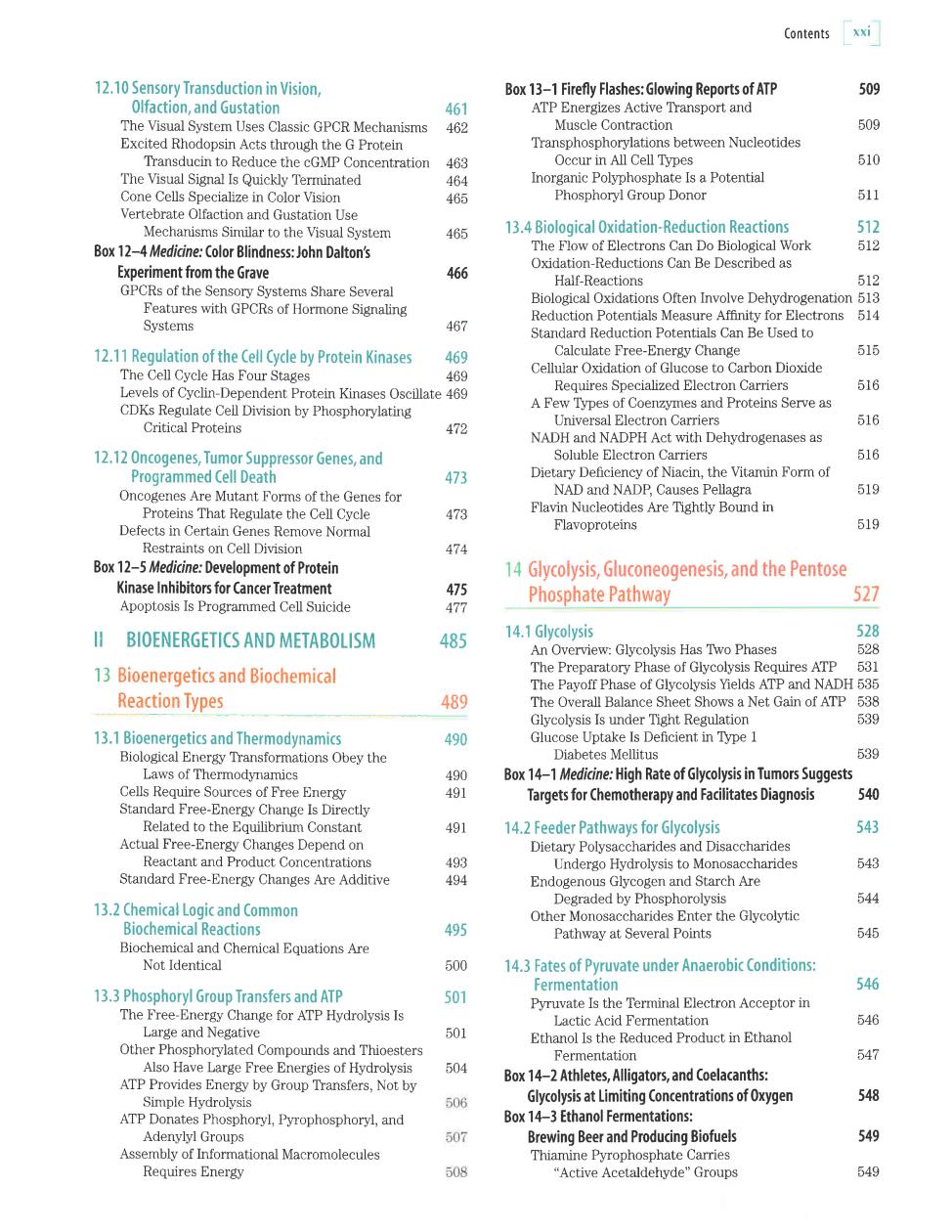
Contentsxxi12.10 Sensory Transduction in Vision,509Box13-1FireflyFlashes:GlowingReportsofATPOifaction,andGustation461ATP Energizes Active Transport and509The Visual System Uses Classic GPCR MechanismsMuscleContraction462Transphosphorylations between NucleotidesExcited Rhodopsin Acts through the GProtein510Occur in All Cell TypesTransducin to Reduce thecGMPConcentration463Inorganic PolyphosphateIs a PotentialTheVisual Signal Is QuicklyTerminated464511Phosphoryl GroupDonorCone Cells Specialize in Color Vision465Vertebrate Olfaction and Gustation Use51213.4 BiologicalOxidation-Reduction ReactionsMechanisms Similar to the Visual System465512TheFlow of Electrons Can DoBiological WorkBox12-4Medicine:ColorBlindness:JohnDalton'sOxidation-ReductionsCanBeDescribedas466ExperimentfromtheGrave512Haif-ReactionsGPCRsof the Sensory Systems Share SeveralBiologicalOxidationsOften InvolveDehydrogenation513Features with GPCRs of Hormone Signaling514ReductionPotentialsMeasureAffinityforElectrons467SystemsStandard Reduction Potentials Can Be Used to515Calculate Free-Energy Change12.11 Regulation of the Cell Cycleby Protein Kinases469Cellular Oxidation of Glucose to CarbonDioxideThe Cell Cycle Has Four Stages469516Requires Specialized Electron CarriersLevels of Cyclin-Dependent Protein Kinases Oscillate 469AFewTypes of Coenzymesand Proteins ServeasCDKs Regulate Cell Division by Phosphorylating516Universal Electron CarriersCritical Proteins472NADH and NADPH Act with Dehydrogenases as516Soluble Electron Carriers12.12Oncogenes,TumorSuppressorGenes,andDietary Deficiency of Niacin, the Vitamin Form of473Programmed Cell Death519NAD and NADP, Causes PellagraOncogenes Are Mutant Forms of the Genes forFlavin Nucleotides AreTightly Bound in473Proteins That Regulate the Cell Cycle519FlavoproteinsDefects in Certain Genes Remove Normal474Restraints on Cell DivisionBox12-5Medicine:Developmentof Protein14Glycolysis,Gluconeogenesis,andthePentoseKinase Inhibitorsfor Cancer Treatment475527Phosphate PathwayApoptosis Is Programmed Cell Suicide47752814.1GlycolysisI485BIOENERGETICSANDMETABOLISM528An Overview:Glycolysis Has TwoPhasesThe Preparatory Phase of Glycolysis Requires ATP53113 Bioenergetics and BiochemicalThePayoffPhaseofGlycolysisYieldsATPandNADH535Reaction Types489The Overall Balance Sheet Shows a Net Gain of ATP538539GlycolysisIsunderTightRegulation13.1Bioenergetics and Thermodynamics490Glucose Uptake Is Deficient in Type1539Diabetes MellitusBiological EnergyTransformations ObeytheBox14-1Medicine:High Rate ofGlycolysis in Tumors SuggestsLaws of Thermodynamics490Cells Require Sources of Free Energy491540TargetsforChemotherapyand FacilitatesDiagnosisStandard Free-Energy Change Is Directly543Related to the Equilibrium Constant49114.2FeederPathwaysforGlycolysisActual Free-Energy Changes Depend onDietary Polysaccharides and DisaccharidesReactant and Product Concentrations493543Undergo Hydrolysis to MonosaccharidesStandard Free-Energy Changes Are Additive494Endogenous Glycogen and Starch Are544Degraded byPhosphorolysis13.2 Chemical Logicand CommonOther Monosaccharides Enter the GlycolyticBiochemical Reactions495545Pathway at Several PointsBiochemical and Chemical Equations Are500Not Identical14.3Fatesof PyruvateunderAnaerobicConditions:546Fermentation13.3 PhosphorylGroup Transfers and ATP501Pyruvate Is the Terminal Electron Acceptor inThe Free-Energy Change for ATP Hydrolysis Is546Lactic Acid Fermentation501Large and NegativeEthanol Is the Reduced Product in EthanolOther Phosphorylated Compounds and Thioesters547FermentationAlso Have Large Free Energies of Hydrolysis504Box14-2Athletes,Alligators,and Coelacanths:ATPProvidesEnergybyGroupTransfers,Notby548Glycolysis at LimitingConcentrations ofOxygen506Simple HydrolysisBox14-3EthanolFermentations:ATPDonatesPhosphoryl,Pyrophosphoryl,and549Adenylyl Groups507Brewing Beerand Producing BiofuelsAssemblyof Informational MacromoleculesThiaminePyrophosphate Carries508549Requires Energy"Active Acetaldehyde"Groups
1 2.10 Sensory Transduction in Vision, 0lfaction, and Gustation The Visual System Uses Classic GPCR Mechanisms Excited Rhodopsin Acts through the G Protein Tlansducin to Reduce the cGMP Concentration The Visual Signal Is Quickly Terminated Cone Cells Specialize in Color Vision Vertebrate Olfaction and Gustation Use Mechanisms Similar to the Visual System Box 12-4 Medicine: Color Blindness: J0hn Dalton's Experiment from the Grave GPCRs ofthe Sensory Systems Share Several Features with GPCRs of Hormone Signaling Systems 12.11 Regulation ofthe Cell (ycle by Protein Kinases 469 The Cell Cycle Has Four Stages 469 Levels of Cyclin-Dependent Protein Kinases Oscillate 469 CDKs Regulate Ceil Division by Phosphorylating Critical Proteins 472 Contents xxi Boxl3-lFireflyFlashes:GlowingReportsofATP 509 ATP Energizes Active Ttansport and Muscle Contraction 509 Ttansphosphorylations between Nucleotides Occur in All Cell T$pes 510 Inorganic Pollphosphate Is a Potential Phosphoryl Group Donor 511 13.4 Biological 0xidation-Reduction Reactions 512 The Flow of Electrons Can Do Biological Work 512 Oxidation-Reductions Can Be Described as Half-Reactions 512 Biological Oxidations Often Involve Dehydrogenation 513 Reduction Potentials Measure Afflnity for Electrons 5I4 Standard Reduction Potentials Can Be Used to Calculate Free-Energy Change 515 Cellular Oxidation of Glucose to Carbon Dioxide Requires Specialized Electron Carriers 516 A Few Tlpes of Coenzymes and Proteins Serve as Universal Electron Carriers 516 NADH and NADPH Act with Dehydrogenases as Soluble Electron Carriers 516 Dietary Deflciency of Niacin, the Vitamin Form of NAD and NADP, Causes Pellagra 519 Flavin Nucleotides Are Tightly Bourd in Flavoproteins 519 1 2.1 2 0ncogenes, Tumor 5uppressor Genes, and Programmed (ell Death 473 461 462 463 +o+ 40D 465 466 467 490 491 49r 500 501 493 494 Oncogenes Are Mutant Forms of the Genes for Proteins That Regulate the Cell Cycte 473 Defects in Certain Genes Remove Normal Restraints on Cell Division 474 Box'12-5 Medicine.' Development of Protein Kinase Inhibitors for Cancer Treatment Apoptosis Is Programmed Cell Suicide II BIOENERGETICS AND METABOLISM 13 Bioenergetics and Biochemical Reaction Types _ 1 3.1 Bioenergetics andThermodynamics Biological Energy Ttansformations Obey the Laws of Thermodynamics Cells Require Sources ofFree Energy Standard Free-Energy Change Is Directly Related to the Equilibrium Constant Actual Free-Energy Changes Depend on Reactant and Product Concentrations Standard Free-Energy Changes Are Additive 13.2 Chemical Logic and Common Biochemical Reactions Biochemical and Chemical Eouations Are Not Identical 13.3 Phosphoryl Group Transfers and ATP The Free-Energy Change for ATP Hydrolysis Is Large and Negative Other Phosphorylated Compounds and Thioesters Also Have Large Free Energies of Hydrolysis ATP Provides Energy by Group Ttansfers, Not by Simpie Hydrolysrs ATP Donates Phosphoryl, Pyrophosphoryl, and Adenylyl Groups Assembly of Informational Macromolecules Requires Energy 475 477 5V7 485 489 490 495 501 504 i 4 Glyeolysis, Glucaneogenesis, and the Pentose Pliosphate Pathtruay 14.1 Glycolysis 528 An Overview: Glycolysis Has TWo Phases 528 The Preparatory Phase of Glycolysis Requires ATP 531 The Payoff Phase of Glycolysis Yields ATP and NADH 535 The Overall Balance Sheet Shows a Net Gain of AIP 538 Glycolysis Is under Tight Regulation 539 Glucose Uptake Is Deflcient in Tlpe 1 Diabetes Mellitus 539 Box 14-1 Medicine:High Rate of Glycolysis in Tumors Suggests Targets for (hemotherapy and Facilitates Diagnosis 540 14.2 Feeder Pathways forGlycolysis 543 Dietary Polysaccharides and Disaccharides Undergo Hydrolysis to Monosaccharides 543 Endogenous Glycogen and Starch Are Degraded by Phosphorolysis 544 Other Monosaccharides Enter the Glycolytic Pathway at Several Points 545 1 4.3 Fates of Pyruvate under Anaelobic (onditions: Ferrnentation 546 Pyruvate Is the Terminal Electron Acceptor in Lactic Acid Fermentation 546 Ethanol Is the Reduced Product in Ethanol Fermentation 547 Box 1 4-2 Athletes, Alligators, and Coelacanths: Glycolysis at Limiting Concentrations ofOxygen 548 Box 14-3 Ethanol Fermentations: Brewing Beer and Producing Biofuels 549 Thiamine P1'rophosphate Carries "Active Acetaldehyde" Groups 549
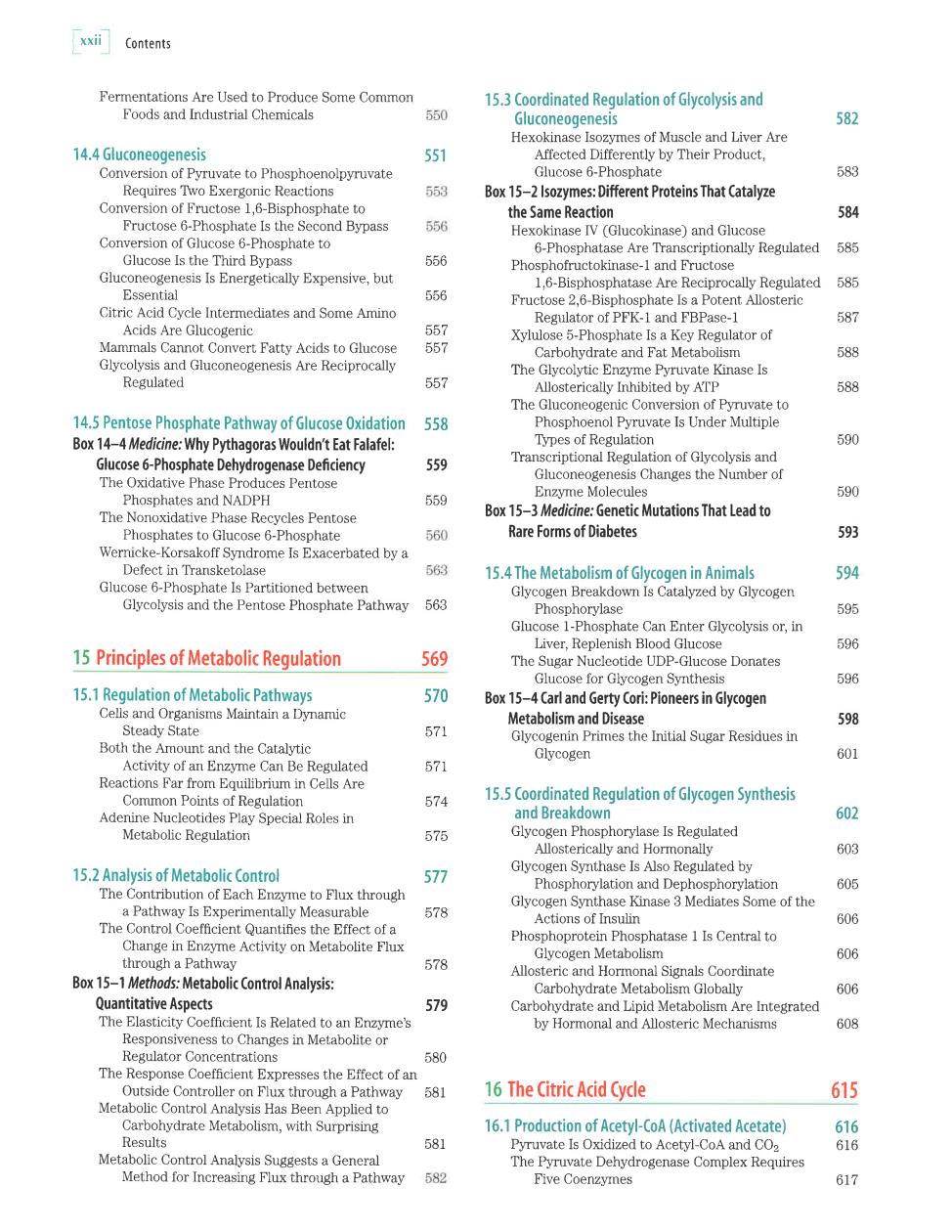
xxiiContentsFermentations Are Used toProduce Some Common15.3Coordinated Regulation ofGlycolysis andFoods and Industrial Chemicals550582GluconeogenesisHexokinase Isozymes of Muscle and Liver Are14.4Gluconeogenesis551Affected Differently by Their Product,583Glucose6-PhosphateConversionof PyruvatetoPhosphoenolpyruvateRequires Two Exergonic Reactions553Box15-2Isozymes:DifferentProteinsThat CatalyzeConversionof Fructose1,6-Bisphosphate to584the Same ReactionFructose6-Phosphate Is the Second Bypass556Hexokinase IV (Glucokinase)and GlucoseConversionof Glucose6-Phosphateto5856-PhosphataseAreTranscriptionallyRegulated556Glucose Is the Third BypassPhosphofructokinase-1 and FructoseGluconeogenesis Is Energetically Expensive,but5851,6-BisphosphataseAreReciprocallyRegulatedEssential556Fructose 2,6-Bisphosphate Is a Potent AllostericCitric Acid Cycle Intermediates and SomeAmino587Regulator of PFK-1 andFBPase-1557Acids Are GlucogenicXylulose5-Phosphate Is a Key Regulator ofMammals Cannot ConvertFattyAcids to Glucose557588Carbohydrate and Fat MetabolismGlycolysis and Gluconeogenesis Are ReciprocallyThe Glycolytic EnzymePyruvateKinase Is557Regulated588AllostericallyInhibited byATPThe Gluconeogenic Conversion of PyruvatetoPhosphoenol Pyruvate Is Under Multiple14.5Pentose Phosphate Pathway of GlucoseOxidation558590TypesofRegulationBox 14-4Medicine:WhyPythagoras Wouldn't Eat Falafel:Transcriptional Regulation of Glycolysis and559Glucose 6-Phosphate Dehydrogenase DeficiencyGluconeogenesis Changes the Number ofThe Oxidative Phase Produces Pentose590Enzyme Molecules559Phosphates and NADPHBox15-3Medicine:GeneticMutationsThat Lead toThe Nonoxidative PhaseRecycles Pentose593RareFormsof DiabetesPhosphates to Glucose 6-Phosphate560Wernicke-Korsakoff SyndromeIs Exacerbated bya563Defect in Transketolase59415.4TheMetabolismofGlycogen inAnimalsGlucose 6-Phosphate Is Partitioned betweenGlycogen Breakdown Is Catalyzed byGlycogen563Glycolysis and the Pentose Phosphate Pathway595PhosphorylaseGlucose1-Phosphate Can Enter Glycolysis or, in596Liver, Replenish Blood Glucose56915Principlesof MetabolicRequlationThe Sugar Nucleotide UDP-Glucose Donates596Glucose for Glycogen Synthesis57015.1RegulationofMetabolic PathwaysBox 15-4Carland Gerty Cori:Pioneers inGlycogenCells and Organisms Maintain a Dynamic598MetabolismandDiseaseSteady State571Glycogenin Primes the Initial Sugar Residues inBoth the Amount and the Catalytic601Glycogen571ActivityofanEnzymeCanBeRegulatedReactionsFarfromEquilibrium inCellsAre15.5Coordinated Regulation ofGlycogen SynthesisCommonPointsof Regulation574602and BreakdownAdenine Nucleotides Play Special Roles inGlycogen Phosphorylase Is RegulatedMetabolic Regulation575603Allostericallyand HormonallyGlycogen SynthaseIsAlsoRegulatedby15.2AnalysisofMetabolicControl577605PhosphorylationandDephosphorylationTheContribution of Each EnzymetoFlux throughGlycogen SynthaseKinase3Mediates Someofthea PathwayIs Experimentally Measurable578606Actions of InsulinThe Control CoefficientQuantifies theEffect of aPhosphoprotein Phosphatase1 Is Central toChange in Enzyme Activity on Metabolite Flux606Glycogen Metabolismthrough a Pathway578Allostericand Hormonal Signals CoordinateBox15-1Methods:MetabolicControl Analysis:606Carbohydrate Metabolism GloballyQuantitativeAspects579Carbohydrateand Lipid Metabolism Are IntegratedThe Elasticity Coefficient Is Related to an Enzyme's608byHormonaland AllostericMechanismsResponsiveness to Changes in Metabolite orRegulator Concentrations580The Response Coefficient Expresses the Effect of an61516The CitricAcid CycleOutside Controlleron FluxthroughaPathway581Metabolic Control Analysis Has Been Applied toCarbohydrate Metabolism,with Surprising16.1Production of Acetyl-CoA (Activated Acetate)616Results581Pyruvate Is Oxidized to Acetyl-CoA and CO,616Metabolic Control Analysis Suggests a GeneralThe Pyruvate Dehydrogenase Complex RequiresMethod for Increasing Flux through a Pathway582617Five Coenzymes
- . l xxt I (o nte nts Fermentations Are Used to Produce Some Common Foods and Industrial Chemicals 14.4 Gluconeogenesis Conversion of P1'ruvate to Phosphoenolpyruvate Requires TWo Exergonic Reactions Conversion of F ructose 1,6-Bisphosphateo Fructose 6-Phosphate Is the Second B5,pass Conversion of Glucose O-Phosphate to Glucose Is the Third Bypass Giuconeogenesis Is Energetically Expensive, but Essential Citric Acid Cycle Intermediates and Some Amino Acids Are Glucogenic Mammais Cannot Convert Fatty Acids to Glucose Glycolysis and Gluconeogenesis Are Reciprocally Regulated 1 4.5 Pentose Phosphate Pathway ofGlucose 0xidation Box14-4 Medicine; Why Pythagoras Wouldn't Eat Falafel: Glucose 6-Phosphate Dehydrogenase Deficiency The Oxidative Phase Produces Pentose Phosphates and NADPH The Nonoddative Phase Recycles Pentose Phosphates to Glucose 6-Phosphate Wernicke-Korsakoff Syrrdrome Is Exacerbated by a Defect in Ttansketolase Glucose 6-Phosphate Is Partitioned between Glycolysis and the Pentose Phosphate Pathway 15.1 Regulation of Metabolic Pathways Cells and Organisms Maintain a Dynamic Steady State Both the Amount and the Catalytic Activity of an Enzyme Can Be Regulated Reactions Far from Equilibrium in Cells Are Common Pohts of Regulation Adenine Nucleotides Play Special Roles in Metabolc Regulation 15.2 Analysis of Metabolic Control The Contribution of Each Enz;.'rne to Flux through a Pathway Is Experimentally Measurable The Control Coefflcient Quantiies the Effect of a Change in Enz5.,rne Activity on Metabolite FIux through a Pathway Box 1 5-1 Methods: ltretabolic Control Analysis: Quantitative Aspects The Elasticity Coefflcient Is Related to an Enzlme's Responsiveness to Changes in Metabolite or Regulator Concentrations The Response Coefflcient Expresses the Effect of an Outside Controller on Flux through a Pathway Metabolic Control Analysis Has Been Applied to Carbohydrate Metabolism, with Surprising Results Metabolic Control Analysis Suggests a General Method for Increasing Flux through a Pathway 15 Principles of Metabolic Regulation 559 15.3 (oordinated Regulation of Glycolysis and Gluconeogenesis Hexokinase IsozJ.rnes ofMuscle and Liver Are Affected Differently by Their Product, Glucose G-Phosphate 583 Box 1 5-2 lsozymes: Different Proteins That Catalyze the Same Reaction Hexokinase IV (Glucokinase) and Glucose 6-PhosphataseAreTtanscriptionallyRegulated 585 Phosphofructokinase- 1 and Fructose 1,6-Bisphosphatase Are Reciprocally Regulated 585 Fructose 2,6-Bisphosphate Isa Potent Allosteric Regulator ofPFK-I and FBPase-l 587 Xylulose 5-Phosphate Is a Key Regulator of Carbohydrate and Fat Metabolism 588 The Glycolytic Enzl'rne P''ruvate Kinase Is Allostericaliy Inhibited by AIP 588 The Gluconeogenic Conversion of Py'ruvate to Phosphoenol Plruvate Is Under Multiple T!'pes of Regulation 590 Ttanscriptional Regulation of Glycolysis and Gluconeogenesis Changes the Number of Enz}''rne Molecules 590 Box15-3 Medicine; Genetic Mutations That Lead to Rare Forms ofDiabetes 15.4The Metabolism of Glycogen in Animals Glycogen Breakdown Is Catalyzed by Glycogen Phosphorylase 595 Glucose 1-Phosphate Can Enter Glycolysis or, in Liver, Replenish Blood Glucose 596 The Sugar Nucleotide UDP-GIucose Donates Glucose for Glycogen Sy'nthesis 596 Box 15-4 Carl and Gerty Cori: Pioneers in Glycogen Metabolism and Disease Glycogenin Primes the Initial Sugar Residues in Glycogen 601 15.5 (oordinated Regulation of Glycogen Synthesis and Breakdown 602 Glycogen Phosphorylase Is Regulated Allosterically and Hormonally 603 Glycogen Synthase Is AJso Regulated by Phosphorylation and Dephosphorylation 605 Glycogen Synthase Kinase 3 Mediates Some of the Actions of Insulin 606 Phosphoprotein Phosphatase 1 Is Central to Glycogen Metabolism 606 Allosteric and Hormonal Signals Coordinate Carbohydrate Metabolism Globally 606 Carbohydrate and Lipid Metabolism Are Integrated bv Hormonal and Allosteric Mechanisms 608 16 The Citric Acid Cycle 615 582 584 551 556 556 557 558 DO.l 559 bbv 593 594 570 598 57r Dtt Dt+ 575 577 578 578 579 580 Dtt 1 16.1 Productionf Acetyl-CoA (Activated Acetate) Pytuvate Is Oxidized to Acetyl-CoA and CO2 The Py'mvate Dehydrogenase Complex Requires Five Coenzr.'rnes 6"t6 oro 617 581
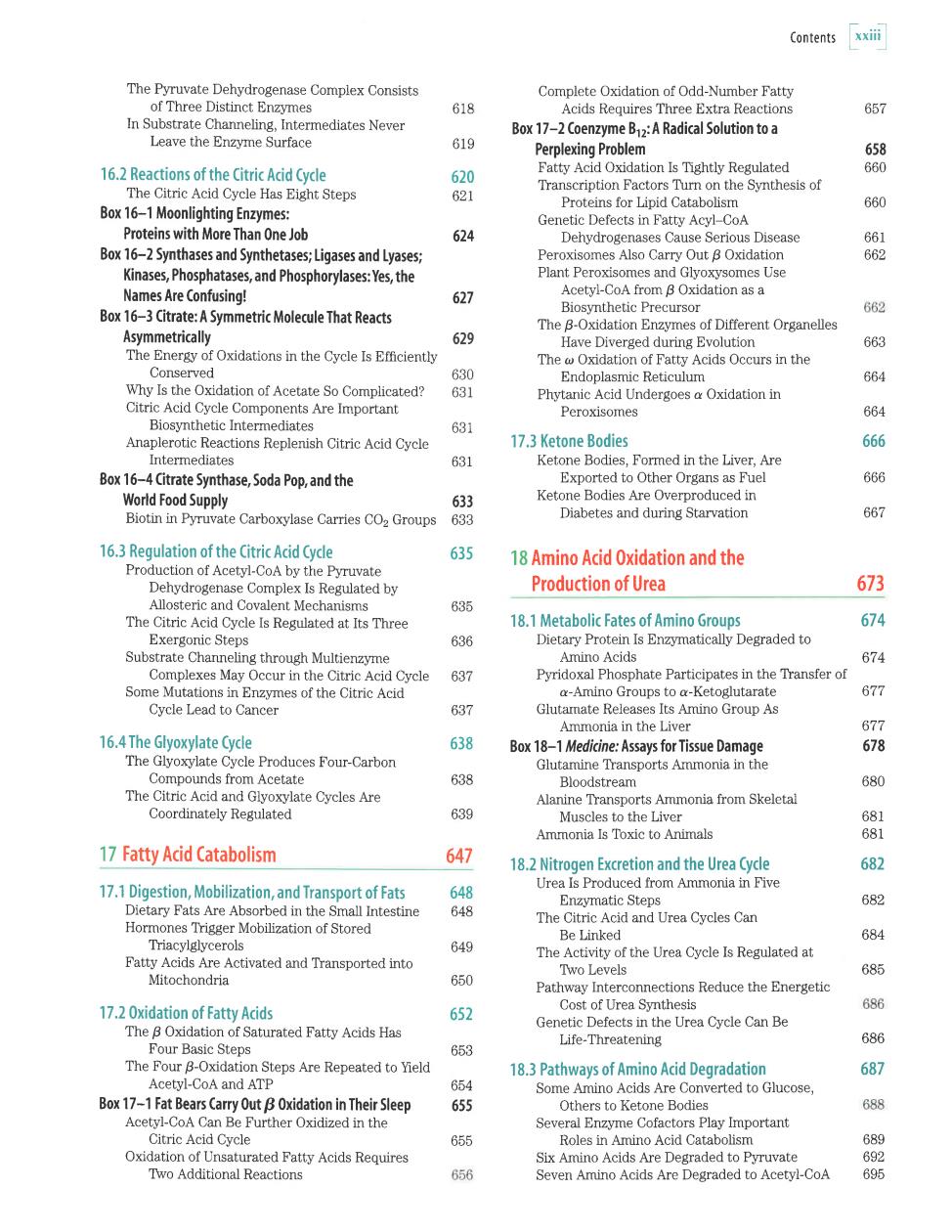
xxiliContentsThePyruvate Dehydrogenase Complex ConsistsComplete Oxidation of Odd-Number Fattyof ThreeDistinctEnzymes618657Acids Requires Three Extra ReactionsIn SubstrateChanneling,Intermediates NeverBox17-2 CoenzymeBi2:A Radical Solution toaLeave the Enzyme Surface619658PerplexingProblem660Fatty Acid Oxidation Is Tightly Regulated16.2 Reactionsof the CitricAcid Cycle620Transcription Factors Turn on the Synthesis ofThe Citric Acid Cycle Has Eight Steps621660Proteinsfor Lipid CatabolismBox16-1MoonlightingEnzymes:GeneticDefects inFatty Acyl-CoAProteins with More Than One Job624661Dehydrogenases Cause Serious Disease662Box 162 Synthases and Synthetases; Ligases and Lyases;Peroxisomes Also Carry Outβ OxidationPlant Peroxisomes and GlyoxysomesUseKinases,Phosphatases,andPhosphorylases:Yes,theAcetyl-CoAfromβOxidationasaNames Are Confusing!627662Biosynthetic PrecursorBox16-3Citrate:ASymmetric Molecule That ReactsTheβ-OxidationEnzymes ofDifferentOrganellesAsymmetrically629663HaveDivergedduringEvolutionThe Energy of Oxidations in the Cycle Is EfficientlyThe w Oxidation of Fatty Acids Occurs in theConserved630664EndoplasmicReticulumWhy Is the Oxidation of Acetate So Complicated?631Phytanic Acid Undergoes α Oxidation inCitric Acid Cycle Components Are Important664PeroxisomesBiosynthetic Intermediates63117.3Ketone Bodies666Anaplerotic Reactions Replenish CitricAcid CycleIntermediates631Ketone Bodies, Formed in the Liver, Are666Exported to Other Organs as FuelBox16-4CitrateSynthase,SodaPop,andtheKetone Bodies Are Overproduced inWorld Food Supply633667Diabetes and during StarvationBiotin inPyruvate Carboxylase Carries CO,Groups63316.3RegulationoftheCitricAcid Cycle63518 Amino Acid Oxidation and theProduction ofAcetyl-CoA by the Pyruvate673Production of UreaDehydrogenase Complex Is Regulated byAllosteric and Covalent Mechanisms63567418.1MetabolicFates of AminoGroupsThe Citric Acid Cycle Is Regulated at Its ThreeExergonicSteps636DietaryProtein Is Enzymatically Degraded toAmino Acids674Substrate Channeling through MultienzymeComplexes May Occur in the Citric Acid CyclePyridoxal PhosphateParticipates intheTransferof637677Some Mutations in Enzymes of the Citric Acidα-Amino Groups to α-Ketoglutarate637Glutarnate Releases Its Amino Group AsCycle Lead to Cancer677Ammonia in the Liver16.4TheGlyoxylateCycle638678Box18-1Medicine:Assays forTissueDamageThe Glyoxylate Cycle Produces Four-CarbonGlutamineTransports Ammonia in the638CompoundsfromAcetate680BloodstreamThe Citric Acid and Glyoxylate Cycles AreAlanineTransports Ammonia fromSkeletal639Coordinately Regulated681Muscles to the Liver681Ammonia Is Toxic to Animals64717FattyAcid Catabolism18.2Nitrogen Excretion and the Urea Cycle682Urea Is Produced from Ammonia in Five17.1DigtionMobilizationandranportfFa648682EnzymaticStepsDietaryFats AreAbsorbed in the Small Intestine648The CitricAcidand UreaCycles CanHormones Trigger Mobilization of Stored684Be LinkedTriacylglycerols649The Activity of the Urea Cycle Is Regulated atFatty Acids Are Activated and Transported into685Two Levels650MitochondriaPathway InterconnectionsReducetheEnergetic686CostofUreaSynthesis17.2Oxidationof FattyAcids652Genetic Defects in the Urea Cycle Can BeTheβ Oxidation of Saturated Fatty Acids Has686Life-ThreateningFour Basic Steps653The Fourβ-Oxidation Steps Are Repeated to Yield68718.3Pathwaysof Amino Acid DegradationAcetyl-CoAandATP654SomeAminoAcidsAreConvertedtoGlucoseBox17-1Fat Bears CarryOutβOxidation in Their Sleep655688Others toKetone BodiesAcetyl-CoACan BeFurther Oxidized in theSeveral Enzyme Cofactors Play Important689Citric Acid Cycle655Roles in Amino Acid Catabolism692Oxidation of Unsaturated Fatty Acids RequiresSix Amino Acids Are Degraded to PyruvateTwo Additional Reactions656695Seven AminoAcidsAreDegraded toAcetyl-CoA
The Pyruvate Dehydrogenase Complex Consists of Three Distinct Enzymes In Substrate Channeling, Intermediates Never Leave the Enzyme Surface 16.2 Reactions of the Citric Acid (ycle The Citric Acid Cycle Has Eight Steps Box 16-1 Moonlighting Enzymes: Proteins with More Than One Job Box 16-2 Synthases and Synthetases; Ligases and Lyases; Kinases, Phosphatases, and Phosphorylases: Yes, the Names Are Confusing! Box 16-3 Citrate: A Symmetric Molecule That Reacts Asymmetrically The Energy of Oxidations in the Cycle Is Efflciently Conserved Why Is the Oxidation of Acetate So Complicated? Citric Acid Cycle Components Are Important Bioslnthetic Intermediates Anaplerotic Reactions Replenish Citric Acid Cycle Intermediates Box 1 6-4 Gtrate Synthase, Soda Pop, and the World Food Supply Biotin in Py'ruvate Carboxylase Carries CO2 Groups 16.3 Regulation of the Citric Acid (ycle Production of Acetyl-CoA by the Py'ruvate Dehydrogenase Complex Is Regr_rlated by Allosteric and Covalent Mechanisms The Citric Acid Cycle Is Regulated at Its Three Exergonic Steps Substrate Charmeling through MultienzSrme Complexes May Occur in the Citric Acid Cycle Some Mutations in Enzy'rnes of the Citric Acid Cycle Lead to Cancer 16.4 The Glyoxylate (ycle The Glyoxylate Cycle Produces Four-Carbon Compounds from Acetate The Citric Acid and Glyoxylate Cycles Are Coordinately Regulated 17 Fatty Acid Catabolism 17.1 Digestion, Mobilization, and Transport of Fats Dietary Fats Are Absorbed in the Small Intestine Hormones Ttigger Mobilization of Stored Tliacylglycerols Fatty Acids Are Activated and Ttansported into Mitochondria 17.2 0xidation ofFatty Acids The B Oxidation of Saturated Fatty Acids Has Four Basic Steps The Four B-Oxidation Steps Are Repeated to Yield Acetyl-CoA and ATP Box 17-1 Fat Bears (arry Out B 0xidation in Their Sleep Acetyl-CoA Can Be Further Oxidized in the Citric Acid Cycle Oxidation of Unsaturated Fatty Acids Requires T\vo Additional Reactions 618 contents F-"1 Complete Oxidation of Odd-Number Fatty Acids Requires Three Extra Reactions Box17-2(oenzyme Btr:A RadicalSolution to a Perplexing Problem Fatty Acid Oxidation Is Tightly Regulated Tlanscription Factors Thm on the Synthesis of Proteins for Lipid Catabolism Genetic Defects in Fatty Acyl-CoA Dehydrogenases Cause Serious Disease Peroxisomes Also Carry Out p Oxidation Plant Peroxisomes and Glyoxysomes Use Acetyl-CoA from B Oxidation as a Biosynthetic Precursor The B-Oxidation Enzymes of Different Organelles Have Diverged during Evolution The ro Oxidation of Fatty Acids Occurs in the Endoplasmic Reticulum Phytanic Acid Undergoes a Oxidation in Peroxisomes 18 Amino Acid 0xidation and the Production of Urea 18.1 Metabolic Fates ofAmino Groups Dietary Protein Is Enzymatically Degraded to Amino Acids Pyridoxal Phosphate Participates in the Ttansfer of a-Amino Groups to a-Ketoglutarate Glutamate Releases Its Amino Group As Ammonia in the Liver Box 18-1 Medicine: Assays forTissue Damage Glutamine Tlansports Ammonia in the Bloodstream Alanine Ttansports Ammonia from Skeletal Muscles to the Liver Ammonia Is Toxic to Animals 18.2 Nitrogen Excretion and the Urea Cycle Urea Is Produced from Ammonia in Five Enz5rmatic StePs The Citric Acid and Urea Cvcles Can Be Linked The Activity of the Urea Cycle Is Regulated at T\wo Levels Pathway Interconnections Reduce the Energetic Cost of Urea Synthesis Genetic Defects in the Urea Cycle Can Be T .i fa-Throqtonin o !u! r rrr !qlvrrr^!o 1 8.3 Pathways of Amino Acid Degradation Some Amino Acids Are Converted to Glucose Others to Ketone Bodies Several Enz].'rne Cofactors Play Important Roles in Amino Acid Catabolism Six Amino Acids Are Degraded to Py'ruvate Seven Amino Acids Are Degraded to Acetyi-CoA 674 674 0c/ 658 obt, 660 bol 662 663 ooz+ 664 619 620 621. 624 627 629 630 o,J 1 631 631 17.3 Ketone Bodies 666 Ketone Bodies, Formed in the Liver, Are Exported to Other Organs as Fuel 666 Ketone Bodies Are Overproduced in Diabetes and during Starvation 667 633 633 635 673 OJD oJo 637 639 647 677 677 678 680 681 681 682 682 684 685 686 687 637 638 638 648 648 649 650 652 ODJ oD4 655 ODD 689 692 ovD
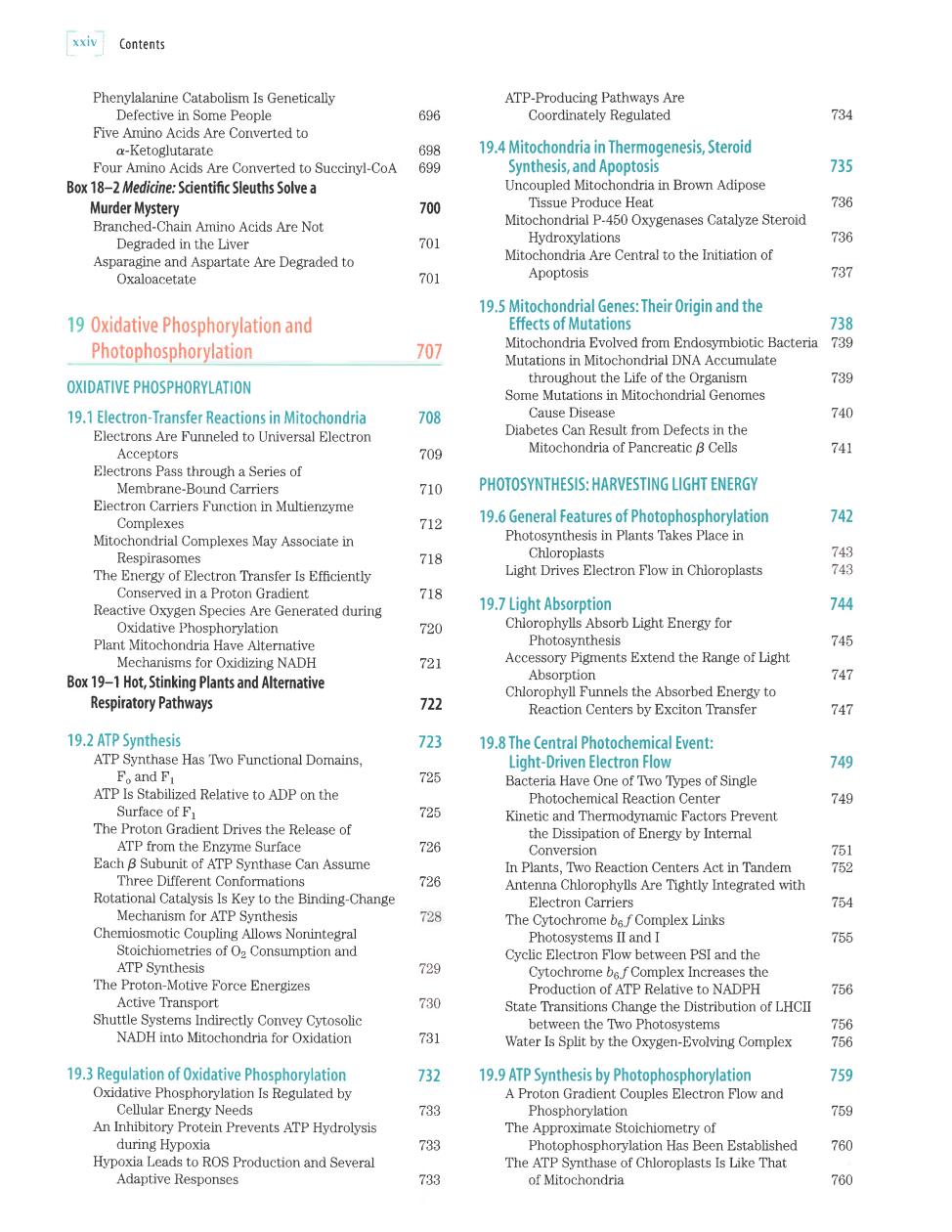
xxivContentsPhenylalanine Catabolism Is GeneticallyATP-Producing Pathways Are734696Coordinately RegulatedDefective inSomePeopleFive Amino Acids Are Converted to19.4Mitochondria inThemogenesis,Steroid698a-Ketoglutarate735Synthesis,and ApoptosisFour Amino Acids Are Converted to Succinyl-CoA699Uncoupled Mitochondria in Brown AdiposeBox18-2Medicine:ScientificSleuths Solvea736Tissue Produce Heat700Murder MysteryMitochondrial P-450Oxygenases Catalyze SteroidBranched-Chain Amino Acids Are Not736Hydroxylations701DegradedintheLiverMitochondria Are Central to the Initiation ofAsparagine and Aspartate Are Degraded to737Apoptosis701Oxaloacetate19.5MitochondrialGenes:TheirOriginandthe73819 Oxidative Phosphorylation andEffectsof Mutations739Mitochondria Evolved from Endosymbiotic Bacteria707PhotophosphorylationMutations in Mitochondrial DNA Accumulate739throughout the Life of the OrganismOXIDATIVE PHOSPHORYLATIONSome Mutations in Mitochondrial Genomes740Cause Disease70819.1Electron-TransferReactions inMitochondriaDiabetes Can Result from Defects in theElectrons Are Funneled to Universal Electron741Mitochondria of Pancreaticβ Cells709AcceptorsElectrons Pass through a Series ofPHOTOSYNTHESIS:HARVESTING LIGHTENERGY710Membrane-Bound CarriersElectron Carriers Function in Multienzyme74219.6GeneralFeatures of Photophosphorylation712ComplexesPhotosynthesis in Plants Takes Place inMitochondrial Complexes MayAssociatein743Chloroplasts718Respirasomes743Light Drives Electron Flow in ChioroplastsThe Energyof Electron Transfer Is EfficientlyConserved in a Proton Gradient71874419.7Light AbsorptionReactive Oxygen Species Are Generated duringChlorophylls Absorb Light Energy for720OxidativePhosphorylation745PhotosynthesisPlant Mitochondria Have AlternativeAccessory Pigments Extend theRange of LightMechanisms for Oxidizing NADH721747AbsorptionBox19-1Hot,StinkingPlants and AlternativeChlorophyll Funnels the Absorbed Energy toRespiratory Pathways722747Reaction Centers by Exciton Transfer19.2ATPSynthesis72319.8The Central Photochemical Event:ATPSynthaseHasTwoFunctionalDomains,749Light-Driven Electron Flow725Foand FiBacteria Have One of TwoTypes of SingleATP Is Stabilized Relative to ADP on the749Photochemical ReactionCenterSurface of Fi725Kinetic and Thermodynamic Factors PreventThe Proton Gradient Drives the Release oftheDissipation of EnergybyInternal726ATPfromtheEnzymeSurface751ConversionEachβSubunit of ATPSynthaseCanAssume752In Plants,TwoReaction Centers Act in Tandem726Three Different ConformationsAntenna Chlorophylls AreTightly Integrated withRotational Catalysis Is Key to the Binding-Change754Electron CarriersMechanismforATP Synthesis728The Cytochrome bsf Complex LinksChemiosmotic Coupling Allows Nonintegral755Photosystems IIandIStoichiometriesof Oz ConsumptionandCyclicElectronFlowbetween PSIand the729ATPSynthesisCytochromebefComplexIncreases theThe Proton-Motive Force Energizes756Productionof ATPRelativetoNADPH730Active TransportState Transitions Change the Distribution of LHCIIShuttle Systems Indirectly Convey Cytosolic756between theTwoPhotosystems731NADH into Mitochondria for Oxidation756Water Is Split by the Oxygen-Evolving Complex19.3RegulationofOxidativePhosphorylation73275919.9ATP Synthesis by PhotophosphorylationOxidative Phosphorylation Is Regulated byAProton Gradient CouplesElectronFlowandCellular Energy Needs733759PhosphorylationAn Inhibitory Protein Prevents ATPHydrolysisThe Approximate Stoichiometry of733during Hypoxia760Photophosphorylation Has Been EstablishedHypoxia Leads to ROS Production and SeveralThe ATP Synthase of Chloroplasts Is Like That733760Adaptive Responsesof Mitochondria
i xxiv , Contents Phenylalanine Catabolism Is Genetically Defective in Some People Five Amino Acids Are Converted to a-Ketoglutarate Four Amino Acids Are Converted to Succinyl-CoA Box18-2 Medicine: Scientific Sleuths Solve a Murder Mystery Branched-Chain Amino Acids Are Not Degraded h the Liver Asparagine and Aspartate Are Degraded to Oxaloacetate 19 fixldative Phosphorylaticn and Photophosphorylation OXIDATIVE PHOSPHORYLATION 19.1 Electron-Transfer Reactions in Mitochondria Electrons Are Funneled to Universal Electron Acceptors Electrons Pass through a Series of Membrane-Bound Carriers Electron Carriers Function in Multienz;'rne Complexes Mitochondrial Complexes May Associate in Respirasomes The Energy of Electron Tfansfer Is Efflciently Conserved in a Proton Gradient Reactive Oxygen Species Are Generated during Oxidative Phosphorylation Plant Mitochondria Have Aiternative Mechanisms for Oxidizing NADH Box 1 9-1 Hot, Stinking Plants and Alternative Respiratory Pathways 1 9.2 ATP Synthesis ATP Synthase Has TWo Functional Domains, Fo and Ft ATP Is Stabilized Relative to ADP on the Surface of F1 The Proton Gradient Drives the Release of ATP from the Enz}.tne Surface Each B Subunit of ATP Synthase Can Assume Three Di-fferent Conformations Rotational Catalysis Is Key to the Binding-Change Mechanism for ATP Synthesis Chemiosmotic Coupling Allows Nonintegral Stoichiometries of 02 Consumption and ATP Synthesis The Proton-Motive Force Energizes Active Transport Shuttle Systems Indirectly Convey C5,'tosolic NADH hto Mitochondria for Oxidation 19.3 Regulation of 0xidative Phosphorylation Oxidative Phosphorylation Is Regulated by Cellular Energy Needs An Inhibitory Protein Prevents ATP Hydrolysis during Hlpoxia Hypoxia Leads to ROS Production and Several Adaptive Responses bYft 698 699 700 70r 701 7U7 ATP-Producing Pathways Are Coordinately Regulated 734 19.4 Mitochondria in Therm0genesis, Steroid Synthesis,and Apoptosis 735 Uncoupled Mitochondria in Brown Adipose Tissue Produce Heat 736 Mitochondriai P-450 Oxygenases Catalyze Steroid Hydroxylations 736 Mitochondria Are Central to the Initiation of Apoptosis 737 19.5 Mitochondrial Genes:Their 0rigin and the 708 Effects of Mutations Mitochondria Evolved from Endoslmrbiotic Bacteria Mutations in Mitochondrial DNA Accumulate throughout the Life of the Organism Some Mutations in Mitochondrial Genomes Cause Disease Diabetes Can Result from Defects in the Mitochondria of Pancreatic B Cells PHOIOSYNTHESIS: HARVESTING LIGHT ENERGY 19.6 General Features of Photophosphorylation Photosy'nthesis in Plants Takes Place in Chloroplasts Light Drives Electron Flow in Chioroplasts 19.7 Light Absorption Chlorophylls Absorb Light Energy for Photosynthesis 738 739 739 740 74r 744 745 747 749 749 709 7r0 712 718 718 720 72r 722 723 742 743 743 725 725 726 726 729 730 / d l Accessory Pigments Extend the Range of Light Absorption 747 Chlorophyll Funnels the Absorbed Energy to Reaction Centers by Exciton Ttansfer 19.8 The Central Photochemical Event: Light-Driven Electron Flow Bacteria Have One of Tlvo Tlpes of Single Photochemical Reaction Center Kinetic and Thermodynamic Factors Prevent the Dissipation of Energy by Internal Conversion 75I In Plants, TWo Reaction Centers Act in Tandem 752 Antenna Chlorophylls Are Tightly Integrated with Electron Carriers 754 The Cytochrome b6lComplex Links Photosystems II and I 755 Cyclic Electron FIow between PSI and the Cyochrome b6lComplex Increases the Production of ATP Relative to NADPH 756 State Ttansitions Change the Distribution of LHCII between the TWo Photosystems 756 Water Is Split by the Oxygen-Evolving Complex 756 19.9 ATP Synthesis by Photophosphorylation 759 A Proton Gradient Couoles Electron Flow and Phosphorylation 759 The Approximate Stoichiometry of Photophosphorylation Has Been Established 760 The ATP Sy'nthase of Chloroplasts Is Like That of Mitochondria 760 732 I t)r) lJJ lJO